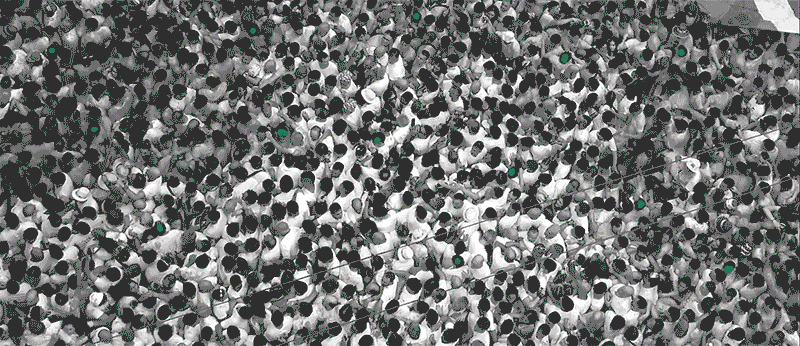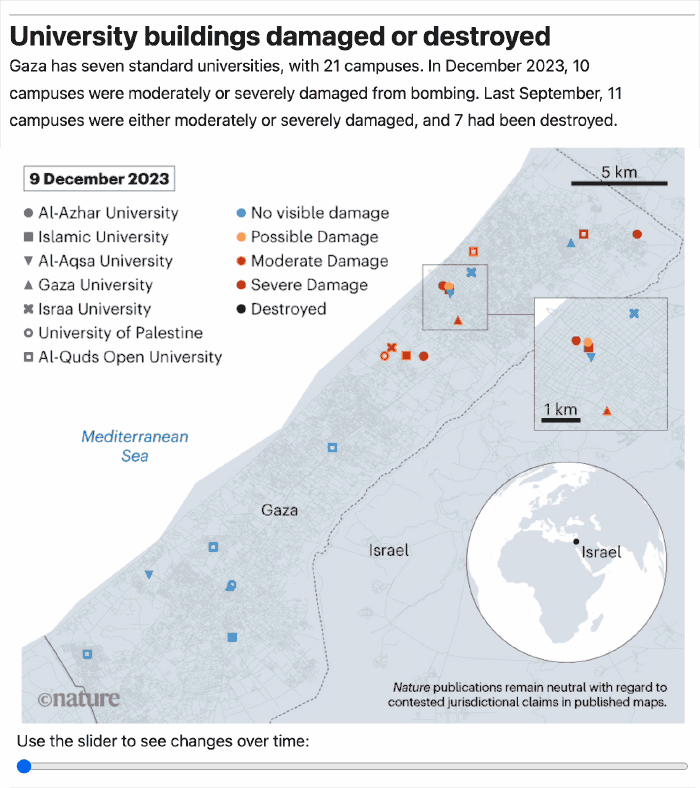Hello Nature readers, would you like to get this Briefing in your inbox free every day? Sign up here.

Tracking of individual heads in this footage of the crowd reveals gradual circular movements.Credit: Bartolo lab, ENS de Lyon
In densely-packed crowds, people form swirling ‘vortex’ patterns, with individuals moving in circles. Researchers studied crowds gathered for the famed Feast of San Fermín celebrations in Pamplona, Spain. They found that, as a central plaza filled up in the morning, the crowd reached a critical density of around four people per square metre, beyond which it started — initially very slowly — to form rotating vortices, each involving hundreds of people, that pushed against one another. The vortices completed a rotation in 18 seconds once the plaza reached its maximum density, of around 9 people packed in each square metre.
Ancient-genomics researchers have pinpointed the homelands of a nomadic tribe that transformed the culture and genetics of Europe and Asia, revealing a potential source for the Indo–European language family, spoken by nearly half of the world’s population. Genomes from more than 400 individuals suggest that the Yamnaya — Bronze Age herders from the grassy plains of present-day Russia and Ukraine — emerged along the northern shores of the Black Sea. “This Indo–European story has been a mystery for 200 years, and now step by step, we are coming closer to the solution,” says archaeologist Volker Heyd.
Reference: Nature paper 1 & paper 2
New research has shed some light on what sea turtles do during a period known as ‘the lost years’ — a span of one to ten years between leaving the beach as hatchlings and returning fully grown. The answer: they’re swimming. Scientists had previously theorized that the babies float passively along ocean currents. Tracking data from 114 individuals of different turtle species revealed that the hatchlings instead go where they please, moving between the continental shelf and the open ocean. “This tiny little hatchling is actually making its own decisions about where it wants to go in the ocean and what it wants to avoid,” said ecologist Bryan Wallace.
Reference: Proceedings of the Royal Society B paper
Features & opinion
Amid the uncertainty and destruction caused by the 15-month conflict between Hamas and Israel, researchers in Gaza have been trying to continue their work. Ten scientists from the territory, some of whom even published during the war, spoke to Nature about continuing their research despite facing homelessness, recurrent displacement and a dearth of food and basic necessities. “The Palestinian academic community’s efforts to continue their work under such difficult circumstances are a testament to their unwavering commitment to education and knowledge,” says online-learning researcher Aya ElMashharawi.

“The temptation to ‘sell out’ is present across the science-communications industry, in which the pressure to stand out might overshadow the responsibility to communicate with integrity,” says communications specialist Kisha Greer. She offers five tips on how to sell research without overhyping it:
1• Set realistic expectations
2• Tailor your message to your audience
3• Be transparent with your data
4• Make your science relatable
5• Don’t take shortcuts, tell the full story
Today I want to learn to ‘speak’ cow, and I’ve found myself a tutor. Sociolinguist Leonie Cornips studies how cows communicate by applying the framework of human languages to the noises they make and their body movements. Watch this space, Nature Briefing: Cow Edition coming soon.
First, help me better communicate with you, our human readers, by sending your feedback to [email protected].
Thanks for reading,
Jacob Smith, associate editor, Nature Briefing
With contributions by Flora Graham
Want more? Sign up to our other free Nature Briefing newsletters:
• Nature Briefing: Careers — insights, advice and award-winning journalism to help you optimize your working life
• Nature Briefing: Microbiology — the most abundant living entities on our planet — microorganisms — and the role they play in health, the environment and food systems
• Nature Briefing: Anthropocene — climate change, biodiversity, sustainability and geoengineering
• Nature Briefing: AI & Robotics — 100% written by humans, of course
• Nature Briefing: Cancer — a weekly newsletter written with cancer researchers in mind
• Nature Briefing: Translational Research — covers biotechnology, drug discovery and pharma


